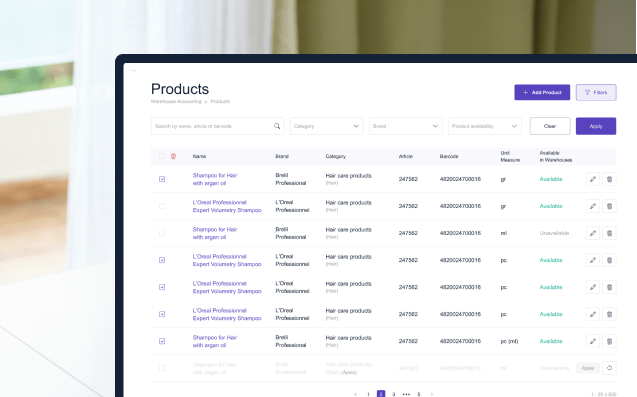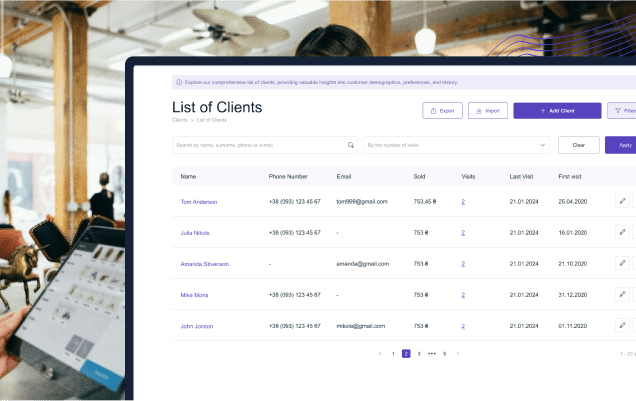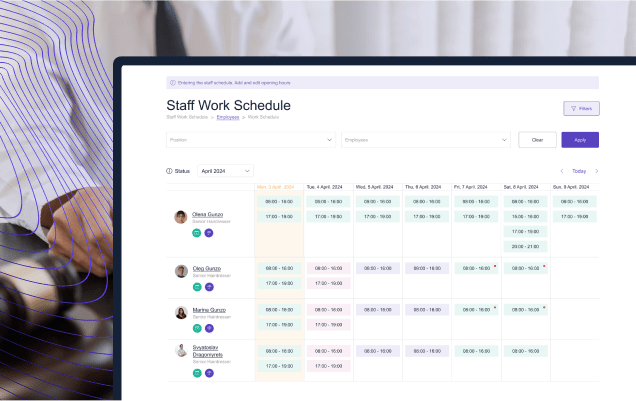What Is E-Booking and How It Can Elevate Your Hotel's Success
The hospitality industry is evolving rapidly, and the integration of technology plays a critical role in shaping guest experiences. One of the most tr...
A POS (Point of Sale) system is a combination of software and hardware designed to automate sales processes and manage business operations in retail and food service establishments. The system includes a cash register, barcode scanners, receipt printers, payment terminals, and software for accounting and sales analysis.
A Point of Sale system enables businesses to efficiently manage sales, inventory, customers, and employees.
Use for Free
The system automatically updates product availability information, helping to avoid errors during inventory checks.

Automation of processes allows for quick transaction processing, reducing customer wait times.

A POS system provides detailed sales reports, enabling business owners to make informed decisions.

Offers various payment methods, including contactless payments and mobile wallets.

Allows tracking customer behavior and offering personalized promotions.

Enables tracking of employee working hours and efficiency.
Solution
A POS system addresses many issues faced by business owners and their customers. It eliminates the need for manual sales and inventory tracking, significantly reducing the risk of errors and the time required for data processing. This is especially crucial for large stores and restaurants with a high volume of products and orders. A POS system also helps avoid long wait times in queues, enhancing customer satisfaction and encouraging their return.
Moreover, by integrating with various payment systems, business owners can offer flexible and convenient payment methods, which also contributes to increased sales and customer loyalty.
Quick and easy installation of the POS system at the point of sale with minimal setup time.
Seamless connection of the POS system with existing CRM and inventory programs, ensuring data synchronization.
Effective training of employees on using the POS system, minimizing errors and increasing productivity.
Automation and simplification of sales and inventory management processes, reducing manual operations and errors.
Ensuring convenience for customers through quick service and flexible payment methods.
Continuous collection and analysis of sales and customer data, implementing improvements based on the gathered information.
Business Categories
Our platform is ideal for a wide range of businesses looking to streamline their processes and enhance customer satisfaction.
Plans
Starter
Free /forever
Available by default upon registration
Lite
... /month
Disables the advertisement in the online booking
Premium
... /month
Ads-free and restrictions of branches and employees
Features
Blog
Stay informed with our latest insights, updates, and tips on optimizing your business with Me-Pos. Discover valuable information to help you succeed.
The hospitality industry is evolving rapidly, and the integration of technology plays a critical role in shaping guest experiences. One of the most tr...
Gathering customer reviews is essential for any business looking to build trust, improve services, and grow its online presence. However, how to ask c...
Starting a hotel business can be an exciting and rewarding venture, but it requires careful planning, significant investment, and a thorough understan...
In the competitive restaurant industry, the debate over service charges vs tips continues to shape customer experiences and employee compensation. As ...
The pet industry is booming, making it an ideal time for starting a pet store business. With pet ownership steadily increasing, the demand for quality...
Real estate is one of the most competitive industries out there. Whether you’re managing dozens of properties, closing sales with clients, or running ...
Designing the floor plan of a restaurant is one of the most crucial steps to building a thriving business. It’s more than just arranging tables—it’s a...
The age-old debate of wholesale vs. retail is more relevant than ever in today’s business world. Understanding the dynamics of these two models isn’t ...
Your beauty parlor is more than a place where clients come for a quick haircut or manicure. It’s a sanctuary, a haven where people go to feel refreshe...
Opening a liquor store can be an exciting and rewarding journey, but it’s not a business you want to jump into without preparation. From understanding...
In a bar, the barback is the hero working behind the scenes, keeping everything running smoothly. While bartenders are out there mixing drinks and cha...
Buying wholesale might sound like a game reserved for businesses, but let us tell you—it’s a goldmine for anyone smart enough to take advantage. Wheth...
Running a bar? Then you need a solid well drinks list to keep things moving. These well drinks are your bread and butter—affordable, quick to make, an...
So, you’re thinking about starting up a small business? That’s awesome! Whether you’re doing it for personal fulfillment, to escape the 9-to-5 grind, ...
So you want to start a food truck? Awesome choice! But before you hit the road, you have to figure out how much food trucks cost and what other expens...
Starting a pharmacy business can be a rewarding and profitable venture if approached correctly. Pharmacies play a crucial role in communities by provi...
Starting a gym business is a rewarding opportunity that combines a passion for fitness with entrepreneurial success. However, it involves far more tha...
Running a retail business is a balancing act. You have to manage products, customers, employees, and the store itself, all while trying to turn a prof...
The wellness industry is booming, offering excellent opportunities for entrepreneurs looking to start a spa business. In today's fast-paced world, mor...
Opening a new bar is an exciting venture, but it requires careful planning and attention to detail. Whether you dream of creating a laid-back pub or a...
Starting an ice cream truck business can be a lucrative and enjoyable venture for those who love being their own boss, engaging with the community, an...
Customer retention refers to a company’s ability to keep its customers over a sustained period, ensuring they continue to choose its products or servi...
As a business owner, managing income tax efficiently is crucial not only for maximizing profits but also for maintaining the long-term financial healt...
In the rapidly evolving landscape of supply chain and logistics, efficient warehouse management has become a cornerstone of business success. As compa...
Opening a restaurant is an exciting yet challenging endeavor that requires more than just a great concept and a mouth-watering menu. Among the first a...
Starting a hair salon can be an exciting and rewarding venture. This comprehensive guide aims to provide you with information on how to open a hairdre...
Choosing the best small business software accounting can be a daunting task, given the multitude of options available in the market. The right softwar...
Starting a nail salon business is an exciting venture that requires careful planning and preparation. The foundation of a successful nail salon lies i...
Opening a beauty salon is an exciting venture that requires careful planning, research, and a clear understanding of the costs involved. Proper planni...
Effective promotion strategies are crucial for the success of any restaurant. This comprehensive guide is designed to help restaurant owners and manag...
Designing a restaurant menu is a crucial aspect of the restaurant industry. A well-crafted menu does more than list the dishes offered; it serves as a...
In the bustling environment of a restaurant, safety, and comfort are paramount for the well-being of workers. Non-slip restaurant industry shoes are c...
This guide will walk you through the essential steps to choosing awesome names for restaurants, ensuring they resonate with your target audience and s...
This guide will walk you through the essential steps to open a bakery shop, from initial planning to the grand opening. Whether you’re a first-time en...
Opening a coffee bar can be a rewarding business venture, combining the love of coffee with the opportunity to create a community space. This comprehe...
The hospitality industry is evolving rapidly, and the integration of technology plays a critical role in shaping guest experiences. One of the most tr...
Gathering customer reviews is essential for any business looking to build trust, improve services, and grow its online presence. However, how to ask c...
Starting a hotel business can be an exciting and rewarding venture, but it requires careful planning, significant investment, and a thorough understan...
In the competitive restaurant industry, the debate over service charges vs tips continues to shape customer experiences and employee compensation. As ...
The pet industry is booming, making it an ideal time for starting a pet store business. With pet ownership steadily increasing, the demand for quality...
Real estate is one of the most competitive industries out there. Whether you’re managing dozens of properties, closing sales with clients, or running ...
Designing the floor plan of a restaurant is one of the most crucial steps to building a thriving business. It’s more than just arranging tables—it’s a...
The age-old debate of wholesale vs. retail is more relevant than ever in today’s business world. Understanding the dynamics of these two models isn’t ...
Your beauty parlor is more than a place where clients come for a quick haircut or manicure. It’s a sanctuary, a haven where people go to feel refreshe...
Opening a liquor store can be an exciting and rewarding journey, but it’s not a business you want to jump into without preparation. From understanding...
In a bar, the barback is the hero working behind the scenes, keeping everything running smoothly. While bartenders are out there mixing drinks and cha...
Buying wholesale might sound like a game reserved for businesses, but let us tell you—it’s a goldmine for anyone smart enough to take advantage. Wheth...
Running a bar? Then you need a solid well drinks list to keep things moving. These well drinks are your bread and butter—affordable, quick to make, an...
So, you’re thinking about starting up a small business? That’s awesome! Whether you’re doing it for personal fulfillment, to escape the 9-to-5 grind, ...
So you want to start a food truck? Awesome choice! But before you hit the road, you have to figure out how much food trucks cost and what other expens...
Starting a pharmacy business can be a rewarding and profitable venture if approached correctly. Pharmacies play a crucial role in communities by provi...
Starting a gym business is a rewarding opportunity that combines a passion for fitness with entrepreneurial success. However, it involves far more tha...
Running a retail business is a balancing act. You have to manage products, customers, employees, and the store itself, all while trying to turn a prof...
The wellness industry is booming, offering excellent opportunities for entrepreneurs looking to start a spa business. In today's fast-paced world, mor...
Opening a new bar is an exciting venture, but it requires careful planning and attention to detail. Whether you dream of creating a laid-back pub or a...
Starting an ice cream truck business can be a lucrative and enjoyable venture for those who love being their own boss, engaging with the community, an...
Customer retention refers to a company’s ability to keep its customers over a sustained period, ensuring they continue to choose its products or servi...
As a business owner, managing income tax efficiently is crucial not only for maximizing profits but also for maintaining the long-term financial healt...
In the rapidly evolving landscape of supply chain and logistics, efficient warehouse management has become a cornerstone of business success. As compa...
Opening a restaurant is an exciting yet challenging endeavor that requires more than just a great concept and a mouth-watering menu. Among the first a...
Starting a hair salon can be an exciting and rewarding venture. This comprehensive guide aims to provide you with information on how to open a hairdre...
Choosing the best small business software accounting can be a daunting task, given the multitude of options available in the market. The right softwar...
Starting a nail salon business is an exciting venture that requires careful planning and preparation. The foundation of a successful nail salon lies i...
Opening a beauty salon is an exciting venture that requires careful planning, research, and a clear understanding of the costs involved. Proper planni...
Effective promotion strategies are crucial for the success of any restaurant. This comprehensive guide is designed to help restaurant owners and manag...
Designing a restaurant menu is a crucial aspect of the restaurant industry. A well-crafted menu does more than list the dishes offered; it serves as a...
In the bustling environment of a restaurant, safety, and comfort are paramount for the well-being of workers. Non-slip restaurant industry shoes are c...
This guide will walk you through the essential steps to choosing awesome names for restaurants, ensuring they resonate with your target audience and s...
This guide will walk you through the essential steps to open a bakery shop, from initial planning to the grand opening. Whether you’re a first-time en...
Opening a coffee bar can be a rewarding business venture, combining the love of coffee with the opportunity to create a community space. This comprehe...
FAQ
Point-of-sale solutions refer to a combination of hardware and software designed to streamline sales processes and manage business operations. A well-designed POS system can help businesses in retail and food service efficiently manage transactions, inventory, and customer data, ultimately improving business performance.
POS system design refers to the process of creating a seamless and user-friendly interface for both employees and customers. A well-designed point-of-sale system ensures smooth operations, reduces transaction errors, and provides a more efficient customer experience.
To build a POS system, you need to assess your business requirements, select appropriate hardware (such as cash registers, barcode scanners, and payment terminals), and choose a software solution tailored to your needs.
A professionally built POS system enhances operational efficiency, reduces manual errors, and offers real-time sales and inventory tracking. It also provides valuable insights through analytics, helping you make informed business decisions and improve customer service.
Contacts

Our contacts
Technical support service works 24/7. Send us an email if you have questions or need consultation.
Knowledge base
Useful articles and tips for a more detailed acquaintance with the Me-Pos service. Answers to frequently asked questions, etc.

ME-Pos and our partners uses cookies to keep site secure, ensure optimal performance, and provide you with personalized ads and experience. Our site will not work correctly without cookies and you will not be able to use it.